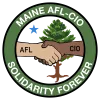Suggested Readings for March, 2023
MAINE AFL-CIO LABOR READING GROUP
Suggestions for March 2023 Reading/listening, to supplement our reading of On the Line by Daisy Pitkin
More on Daisy Pitkin’s On the Line
The Dig podcast (10-2-2022, 1:50:11)
Micah Uetricht,
"Anatomy of an Organizing Drive"
Jacobin Magazine, 10-30-2022
Starbucks Campaign
Pitkin is currently working on Workers United’s Starbucks campaign
Hannah Faris,
"Starbucks Workers Are Facing Down One of the Most Intense Union-Busting Campaigns in Decades"
In These Times, Mar. 21, 2022
John Logan,
“High-Octane Organizing at Starbucks”
New Labor Forum, Nov. 2022:
Noam Scheiber,
"Starbucks Violated Labor Law in Buffalo Union Drive, Judge Rules”
New York Times, March 1, 2023
Starbucks Workers United (Union Website)
UNITE-HERE Merger and Divorce
Pitkin was hired to organize Sodex(h)o laundry workers in Phoenix by UNITE. In 2004, in the middle of the Sodex(h)o drive, UNITE merged with HERE, a union which had been organizing hotel and restaurant workers. As Pitkin describes, the merger had been negotiated by the Presidents of the two unions but was poorly implemented on the ground.
Then a third union, SEIU, became involved in this internal power struggle. SEIU’s President, Andy Stern, had thought all along that both unions should merge with SEIU.
Eventually, in 2009, UNITE-HERE’s President resigned to become President of a new union, Workers United (WU), taking some 100,000 former UNITE members with him. Workers United did affiliate with SEIU, which began raiding UNITE-HERE locals. Eventually, the Presidents of all three unions (WU, UNITE-HERE and SEIU) retired in quick succession, and the UNITE/HERE matter was resolved in 2010.
Meanwhile many felt this bitter and convoluted dispute deprived organized labor of influence it might have had otherwise in the Obama Administration and prevented passage of legislation that would have required union recognition after a majority of workers had signed authorization cards, without having to ratify that choice by means of an election.
William Johnson
"The UNITE-HERE Merger: Is It a Step Forward ... Or Business As Usual"
Labor Notes, April 1, 2004:
Steven Greenhouse
“Infighting Distracts Unions at a Crucial Time”
New York Times, July 8, 2009
Max Fraser
“The SEIU Andy Stern Leaves Behind”
Nation, July 5, 2010
David Moberg
“UNITE HERE, SEIU Resolve Major Dispute, Agree on Division of Money, Members, Organizing”
In These Times, July 27, 2010
Contemporary Labor Movement Overview
Gabriel Winant
“Strike Wave”
NLR Sidecar, November 25, 2021
Jeremy Brecher
“How to Revive the Labor Movement”
Dissent, Feb. 3, 2023:
Some Questions for Discussion
1) The wave of union mergers that occurred in the AFL-CIO over the last 20 years. The merger Pitkin describes-- between HERE and UNITE and the subsequent involvement of SEIU-- was particularly messy. Are we clear on the details? Many of us remember when OCAW merged with UPIU, which represented many papermakers, in 1999 to become PACE, and when PACE was taken over by USW about 5 years later. How have these or other mergers affected you?
2) Do you see contradictions between what we'll call organizing-for-solidarity, which is fundamental for success on the ground, and organizing-for-NLRB-success, which is necessary in today's hostile law-law environment? If so, what are they?
3) Beginning in the 1990s, international unions began hiring college-educated organizers, the better to navigate the choppy legal waters surrounding organizing in the post-Reagan years. (My friend Jack McKay from Food AND Medicine was part of this first wave.) What are the contradictions inherent in having well educated middle class people organizing, particularly in jobs where the workers are low-wage, food-insecure, housing-insecure, may be undocumented, and may not speak English?
